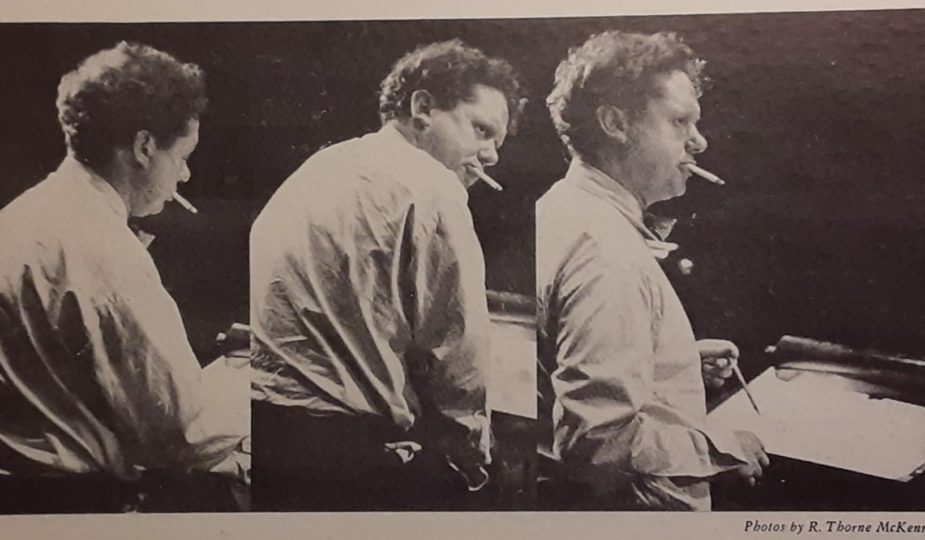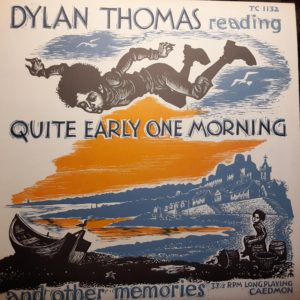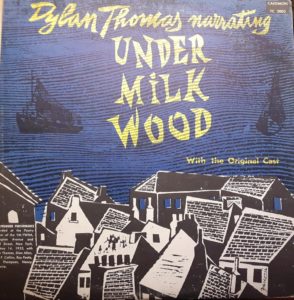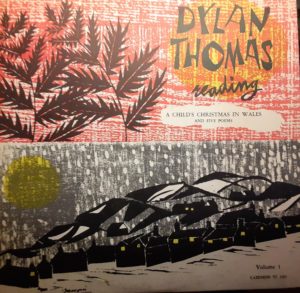
Dylan Thomas’ Caedmon Readings: Childhood, Death, and the Welsh Wild Wonder
On June 10, 1914, the same month that Archduke Franz Ferdinand was assassinated, leading later that summer to the “Great War” (World War I) in Europe, on the other side of the Atlantic, in a tiny town named Engelberg, Arkansas, Ida Layton was born. On October 27, 1914, back across the Atlantic in Swansea, Dylan Thomas was born. Ida Layton left behind that tiny town in Arkansas and moved north to the city of St. Louis, Missouri where she and her husband had a farm north of the city and she gave birth to and raised thirteen children. Ida Layton is my grandmother. She passed away at the old age of eighty-nine on November 8, 2003, only three months after I began college at the age of eighteen. Dylan Thomas became a famous poet, had three children with his wife Caitlin MacNamara, and only lived until the young age of thirty-nine, dying on November 9, 1953 at St. Vincent’s hospital in New York City from alcoholic complications. Dylan Thomas is my favorite poet.
Ida Layton and Dylan Thomas had two lives as completely different as could be. The two of them did share one element- Welsh ancestry. The meaning of my grandmother’s maiden name is, roughly translated, “leek land”, and her mother Mary Melton’s maiden name, roughly translated, means “middle land” and is derived from the same origin as the surname Middleton. My mother Mary was named after her grandmother Mary Melton. My mother and I share Mary Melton’s dark brown, straight hair and green eyes. The leek is the national plant of Wales and the “middle lands” referred to in Melton are the counties of England, such as Shropshire, that bordered Wales.
I discovered Dylan Thomas’ poetry as an adolescent and at the age of twenty-six traveled abroad for the first time and wandered around England and Wales for a month. I ate cawl cennin (leek and potato soup, which has now become my favorite soup) and Glamorgan sausages (much tastier than meat, they are made from bread crumbs, garden herbs, and Welsh cheese). I drank local farmhouse Welsh cider in the pub in Swansea where Dylan Thomas used to drink. I walked the mossy cliffs of the Gower Peninsula and Rhossili where Dylan Thomas used to walk for inspiration with his best friend Vernon Watkins, the fresh, salty, stinging sea spray and windy waves invigorating me. I visited his grave in Laugharne at St. Martin’s. In my family tree, I have German on my biological father’s paternal side and French on my biological father’s maternal side. I have German on my mother’s paternal side and Celtic (Welsh and Irish) ancestry on my mother’s maternal side. I always felt like a stranger in my home state of Missouri. I’ve always felt like a stranger in the United States. Wales is one of the rare regions where I felt that fleeting sense of home.
During the early 1950s, Dylan Thomas embarked upon several trips to the United States where he performed public readings. In 1952, two brilliant young women named Barbara Holdridge and Marianne Mantell after, according to the liner notes, “poems were discussed over rounds of beer”, convinced Dylan Thomas to read his greatest poems (“Fern Hill”, “Ceremony after a Fire Raid”) and his short story “Child’s Christmas in Wales” in a session for their brand new record label Caedmon. I have dabbled in poetry throughout the years and published a few poems, but I am a dilettante. I have not published a book length collection of poems. However, I have been an avid poetry reader from my adolescence through my twenties and into my thirties. The art of poetry is a marriage of imagery and sounds. The art of storytelling is less about sounds and more about imagery. For thousands of years, both were spoken rather than written. Dylan Thomas’ Caedmon readings are a resplendent resurrection of this tradition.
Dylan Thomas’ Caedmon readings are treasures in my collection of vinyl.  Each record contains beautiful covers. The Caedmon record of Quite Early One Morning and other Memories was illustrated by German artist Fritz Eichenberg, who also illustrated Dylan Thomas’ book version of Child’s Christmas in Wales (published after his death) and Fyodor Dostoevsky’s masterpiece The Brothers Karamazov. The Caedmon records Under Milk Wood and Child’s Christmas in Wales and Five Poems were illustrated by Argentine artist Antonio Frasconi.
Each record contains beautiful covers. The Caedmon record of Quite Early One Morning and other Memories was illustrated by German artist Fritz Eichenberg, who also illustrated Dylan Thomas’ book version of Child’s Christmas in Wales (published after his death) and Fyodor Dostoevsky’s masterpiece The Brothers Karamazov. The Caedmon records Under Milk Wood and Child’s Christmas in Wales and Five Poems were illustrated by Argentine artist Antonio Frasconi.
“Quite Early One Morning” remembers a “ferocious night” when “someone in a smoky ship bar said he could feel his tombstone shaking even though he was not dead” and the following morning, repeating the refrain, “the town was not yet awake.” He describes the din of rising sleepers throughout the town, portraits of adults and children, their routines and their teatimes and their thoughts.
In “Reminiscences of Childhood”, he calls Swansea an “ugly, lovely town.” His memories overflow with the sights of “crowds in the streets with leeks in their hats” and the “hunchback in the park”, the smells of fish in the harbor, the bragging conversations and sharing of secrets with schoolmates. As a boy, he flies over Swansea, presenting a panoramic view of the village.
“A Visit to Grandpa’s” is a marvelous meditation on mortality from a boy’s perspective. Dylan Thomas’ mellifluous voice recreates the voice of his grandfather as he mutters about the orchards and the wind. The crux of the story is Grandpa’s musings on death and St. Stephen’s cemetery.
“Holiday Memory” is a humorous reverie summoning “skyblue” summertime tales- balloons, beautiful beaches, boats coughing, carnival mirrors, confetti, music, relatives, rowdy dogs, sand in the sandwiches and sponge cakes, swimmers, the smell of Saturday night, and the fair’s lights fading into the darkness of the night.
 Under Milk Wood was, as the liner notes on the record say, Dylan Thomas’ “final, bawdy, beautiful work.” Dylan Thomas’ opening narration (“it is spring, moonless night in the small town, starless and bible black, the cobbled streets silent”) inspired a decade later perhaps the most cinematic, haunting jazz song of all time (Stan Tracey’s “Starless and Bible Black”). Amazingly, Dylan Thomas was still writing the last lines of this play the day it premiered. It is incredible that only Dylan Thomas and five American actors read lines for fifty-three different characters. A cast of characters this gigantic and so many voices is overwhelming, so I admit that I am not as fond of this recording as I am of Dylan Thomas’ solo readings. His gift for humor and imagery still shine strongly through, though.
Under Milk Wood was, as the liner notes on the record say, Dylan Thomas’ “final, bawdy, beautiful work.” Dylan Thomas’ opening narration (“it is spring, moonless night in the small town, starless and bible black, the cobbled streets silent”) inspired a decade later perhaps the most cinematic, haunting jazz song of all time (Stan Tracey’s “Starless and Bible Black”). Amazingly, Dylan Thomas was still writing the last lines of this play the day it premiered. It is incredible that only Dylan Thomas and five American actors read lines for fifty-three different characters. A cast of characters this gigantic and so many voices is overwhelming, so I admit that I am not as fond of this recording as I am of Dylan Thomas’ solo readings. His gift for humor and imagery still shine strongly through, though.
Dylan Thomas’ first Caedmon reading is still his most magnificent and memorable- his  most nostalgic and popular story (“Child’s Christmas in Wales”) and his greatest poems “Fern Hill” and “Ceremony after a Fire Raid”. “Child’s Christmas in Wales” contains Dylan Thomas’ atmosphere, humor, imagery, musicality, mystery- “in goes my hand into that wool white, bell tongued ball of holidays resting at the rim of the carol singing sea… December in my memory as white as Lapland although there were no reindeer, but there were cats… hurled our snowballs at the green of their eyes… snow grew overnight on the roofs of the houses like a pure and grandfather moss… there was sherry and walnuts and bottled beer… Auntie Hannah who liked port stood in the middle of the snowbound backyard singing like a big bosomed thrush… ghosts whooed like owls in the long nights when I dared not look over my shoulder, animals lurked in the cubby hole under the stairs where the gas meter ticked… the winds through the trees made noises as of old and unpleasant and maybe web footed men wheezing in caves… perhaps it was a ghost… perhaps it was trolls… Auntie Hannah… sang a song about bleeding hearts and death and then another in which she said her heart was like a bird’s nest…”
most nostalgic and popular story (“Child’s Christmas in Wales”) and his greatest poems “Fern Hill” and “Ceremony after a Fire Raid”. “Child’s Christmas in Wales” contains Dylan Thomas’ atmosphere, humor, imagery, musicality, mystery- “in goes my hand into that wool white, bell tongued ball of holidays resting at the rim of the carol singing sea… December in my memory as white as Lapland although there were no reindeer, but there were cats… hurled our snowballs at the green of their eyes… snow grew overnight on the roofs of the houses like a pure and grandfather moss… there was sherry and walnuts and bottled beer… Auntie Hannah who liked port stood in the middle of the snowbound backyard singing like a big bosomed thrush… ghosts whooed like owls in the long nights when I dared not look over my shoulder, animals lurked in the cubby hole under the stairs where the gas meter ticked… the winds through the trees made noises as of old and unpleasant and maybe web footed men wheezing in caves… perhaps it was a ghost… perhaps it was trolls… Auntie Hannah… sang a song about bleeding hearts and death and then another in which she said her heart was like a bird’s nest…”
“Fern Hill” is a mystical nature poem about the paradise lost of early childhood:
“I lordly had the trees and leaves trail with daisies and barley down the rivers of the windfall light…and nightly under the simple stars as I rode to sleep the owls were bearing the farm away…Time held me green and dying though I sang in my chains like the sea.”
“Ceremony after a Fire Raid” is Dylan Thomas’ most powerful poem and, in my opinion, the most powerful poem about war of all time. I always share this poem with my students. This is a poem that must be chanted and proclaimed, which is why it is so important to hear Dylan Thomas read it. “Ceremony after a Fire Raid” was written by Dylan Thomas in 1945, the climax of the worst war in human history (World War II), after he heard the news about a child dying because of a bomb drop. The first stanza is an intense lament of suffering-
A star was broken
Into the centuries of the child
Myselves grieve now, and miracles cannot atone
Forgive
Us forgive
Us your death that myselves the believers
May hold it in a great flood
Till the blood shall spurt
And the dust shall sing like a bird
As the grains blow, as your death grows, through our heart
The line “the dust shall sing like a bird” became the title of my short novella that I wrote in October 2016 when I felt depressed and saddened by the civil war in Syria, a story that unfolds during twenty four hours in Aleppo.
Dylan Thomas’ Caedmon readings are astonishing, bold explorations of childhood and death imbued with a Welsh wild wonder.
by Mark Lager

Superb tribute. Always looking forward your articles.
Thank You Leigh!
Great article, Mark. You produce some fascinating interesting information here. And giving us your background and attachment to the work of Mr Thomas brings everything together. Congratulations.
Cheers Shawn!
Rewarding read, very informative and insightfu. Dylan Thomas is certainly an interesting character, didn’t know nothing about him. I also believe that the record is a privilege for native speakers of English.
I always appreciate your insights on these type of rather unknown characters/records. I’ll check out the record.
Thank you Mark!
Cheers Octavio!
That’s certainly one obscure record. I have a vinyl, “Kinski reads Villon” that’s my favourite. But I’ll give this a listen, great article!
Cheers Chris!
He doesn’t sound Welsh at all, but very formal. Big surprise to me.
Neil,
He was Welsh (born and raised in Swansea, I can hear his subtle Welsh accent), but spoke English and wrote his poems in English.
Wonderful how you weave in the stories of grandmother Ida Layton with that of Dylan Thomas, and how that captures the “childhood reminiscence” qualities of Dylan’s poems. I know nothing about Dylan since every nation / region likes to deal with their own poets, and we have plenty in Germany. But i shall habe a look at him. But listening to that recording is hardcore and impossible with my English listening skills, it is a privilege just for native speakers of English I think.
Saliha,
Dylan Thomas was one of the greatest poets of all time at summoning, like a magician, childhood consciousness–its dreams, fantasies, reveries. Highly Recommend listening to him read his short story “Child’s Christmas in Wales” and his poem “Fern Hill”.